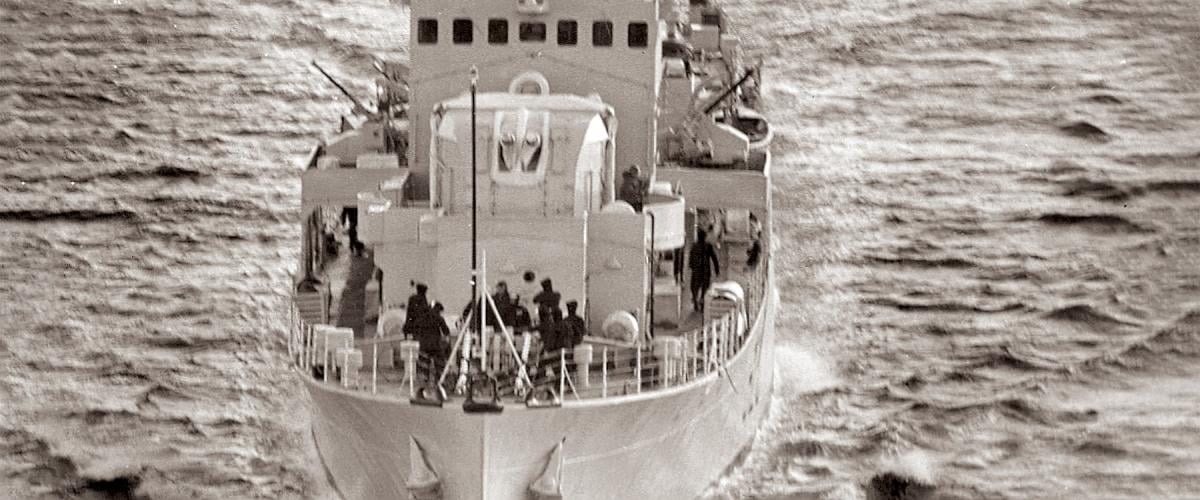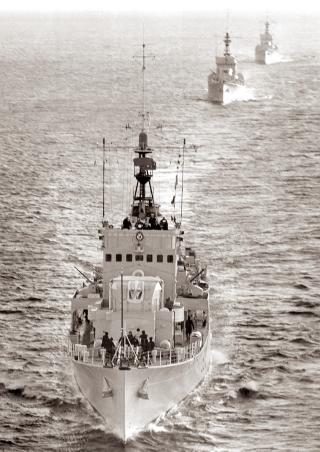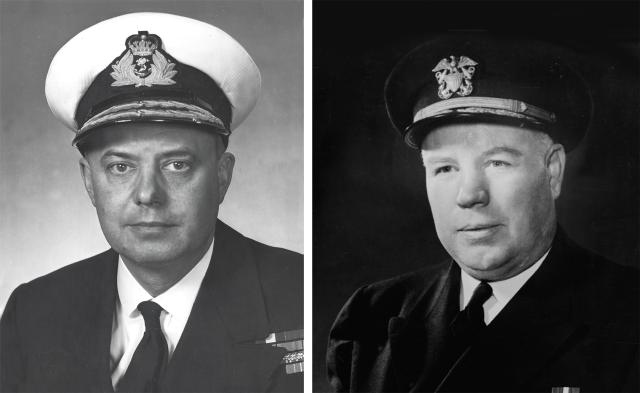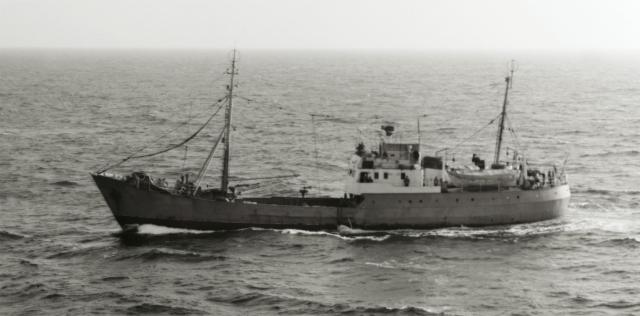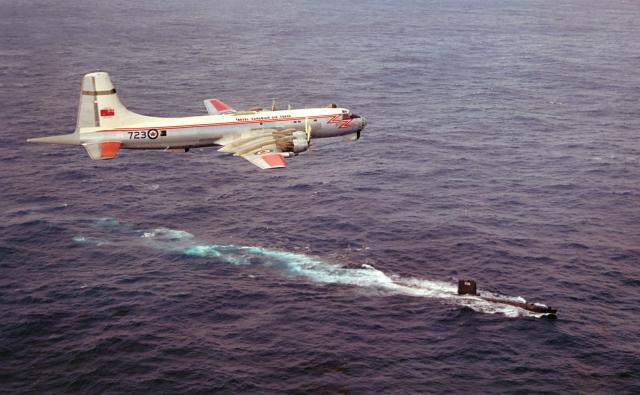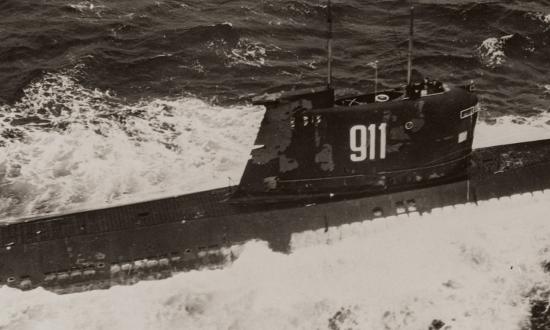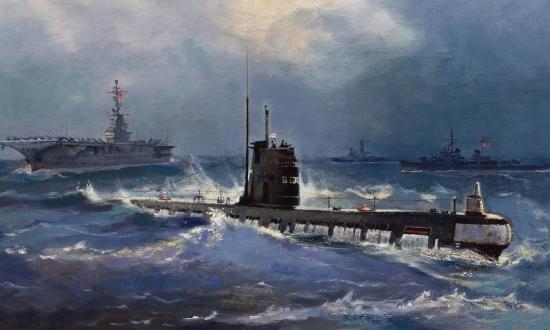On 17 October 1962, a shiny new U.S. Navy P3 Orion taxied up the tarmac of HMCS Shearwater, the home of Canadian naval aviation, outside Halifax, Nova Scotia. Aviators cast admiring eyes over the new maritime patrol aircraft (MPA), unsuspecting of the critical mission of a passenger it bore. Vice Admiral E. B. “Whitey” Taylor, Commander, Antisubmarine Warfare Force, U.S. Atlantic Fleet, had come to brief Royal Canadian Navy Rear Admiral Ken Dyer, Flag Officer Atlantic Coast, on alarming intelligence of Soviet activities in the North Atlantic, particularly a conspicuous increase of Soviet Bloc ships heading for Cuba.
Their discussions shaped the near-seamless cooperation that unfolded between their forces during the Cuban Missile Crisis—cooperation based on mutual trust extending back to the early days of World War II’s Battle of the Atlantic. In the autumn of 1962, that collaboration saw Canadian maritime forces anchor the U.S. Navy’s northern flank, including taking responsibility for some American sectors, thus allowing the U.S. Atlantic Fleet to shift assets to quarantine operations off Cuba.
These Canadian activities were highly classified and remain virtually unknown to this day—but they illustrate the importance of maritime partnerships in times of emergency.1
Establishing the ‘Stonewall’
The command relationship between Dyer and Taylor was governed by a veritable Scrabble board of titles and responsibilities that saw them wearing numerous hats related to their national, bilateral, or NATO responsibilities.
In the simplest terms, as CANCOMARLANT, Dyer led Canada’s maritime forces in the Atlantic, both navy and air force, and, under U.S.-Canadian bilateral agreements beyond his NATO obligations, he commanded the Canadian Atlantic Sub Area (CANLANT). In that capacity, Dyer worked under Taylor’s boss, Admiral Robert Denison, Commander, U.S. Atlantic Fleet (CINCLANT), in the maritime defense of North America. Antisubmarine warfare (ASW) was the dominant consideration, and under the unified command structure, Dyer and Taylor were charged with implementing agreed-upon responses during an emergency.
The emerging Cuban crisis was such an instance. We do not know the specifics of their conversations in Halifax, but one can surmise that the American alerted his Canadian ally that an increase in Soviet shipping activity in the Atlantic portended the export of Soviet arms to Cuba—they did not yet know that these included nuclear weapons—and that they agreed on plans to implement if the situation escalated. Two measures had priority: establishing an antisubmarine barrier and monitoring Soviet fishing trawlers.
The Soviet submarine threat was serious. Their few nuclear boats were too unreliable for extended operations, but they boasted about two dozen Foxtrot-class conventional boats with global reach, and, more disturbing, a handful of Zulu-class submarines capable of launching nuclear missiles against strategic targets along the Eastern Seaboard of North America. On 22 October, a U.S. Navy P2V Neptune sighted a Zulu refueling from a tanker near the Azores, sparking fears it may be headed into the northwest Atlantic.2 Since the CANLANT area straddled the Great Circle Route that Soviet submarines would take to North American waters, on 24 October Admiral Denison directed the “Argentia SUBAIR ASW Barrier” be formed. Dubbed “Stonewall,” the barrier stretched some 600 nautical miles south-southeast from the approaches to Cabot Strait into the northwest Atlantic.
The maritime tripwire eventually comprised ten U.S. Navy ASW submarines supported by 17 MPAs that patrolled a 150-mile swath ahead of the submarine line. Both submarines and aircraft worked closely with “Willie Victor 2” early warning aircraft and the U.S. Navy Sound-Surveillance System (SOSUS) station at Argentia, Newfoundland.3 Since the U.S. Navy’s P2V Neptunes lacked the range to cover the outermost extremities of the barrier, that task was undertaken by Royal Canadian Air Force Canadair Argus MPAs.
Arguably the most capable MPAs in service, Arguses had unrivaled range and an extensive sonar and weapon suite. Stonewall duty became their major focus during the crisis, and they carried out 42 such patrols over a three-week period, each lasting about 17 hours. Although the Stonewall barrier ran through the CANLANT zone, Dyer had a limited measure of command, directing only the activities of his Arguses and two British submarines under Royal Canadian Navy operational control that were positioned northeast of the barrier. Although they gained a few potential contacts, the Stonewall forces did not make confirmed contact with any Soviet submarines.
The Trawler Menace
Trawlers are generally not considered potent maritime threats, but by this stage of the Cold War, the Soviet “fishing fleet,” which loosely included trawlers, oilers, factory ships, tugs, and intelligence vessels (AGIs), was taken seriously by allied naval planners.
The number loitering off eastern Canada had grown steadily from 20 vessels in the spring of 1957 to almost 300 in the summer of 1962; about the same number operated along the U.S. seaboard. Most of these vessels actually fished, but analysts knew they also could monitor the movements of allied warships and aircraft, disrupt communications networks, and support submarines by providing fuel, cover, or navigation information.
The U.S. and Royal Canadian navies had concrete instances of hostile activity that stoked apprehension. In October 1957, a Canadian aircraft had photographed a Soviet trawler with what appeared to be a hose draped over her stern. Intelligence analysts initially thought the trawler was refueling a submarine, but closer scrutiny revealed she had raised a section of a transatlantic cable for purposes unknown.
Worse, on three occasions in 1961, Soviet trawlers had been suspected of cutting U.S. Ballistic Missile Early Warning System cables running between Greenland and Baffin Island. Analysts had no smoking gun per se, but fishing vessels invariably were present when the breaks occurred. Given the nature of these activities, there was real concern the Soviets would attempt to disable elements of the SOSUS network extending along the Eastern Seaboard, which was critical to the Canadian/U.S. ASW defense system.4
Monitoring the submarine and trawler threats became Rear Admiral Dyer’s priority during CUBEX, as the Canadians designated their operations during the Cuban Missile Crisis. If hostilities did commence, Dyer needed to know the location of the enemy, and for three weeks from the end of October into November, he deployed considerable air and sea assets on surveillance operations. Along with working the Sub-Air Barrier off Newfoundland, Argus MPAs patrolled the outer limits of the CANLANT area while Royal Canadian Navy CS2F Trackers and Royal Canadian Air Force Neptunes blanketed inshore waters. Particular attention was accorded to areas around the SOSUS arrays extending from Argentia, Newfoundland, and Shelburne, Nova Scotia.
In an instance of horrible timing, Dyer initially had to rely solely on his shore-based MPAs since the Royal Canadian Navy’s only aircraft carrier, HMCS Bonaventure, was on a cruise to European waters when the crisis broke. Although the carrier played an important role in the later stages of CUBEX after hurrying home, the absence of the Bonaventure and her Tracker aircraft deprived Dyer of a valuable ASW asset—and underscored the weakness of having only one such platform.
MPAs detected a few possible submarine contacts in the CANLANT area, but, importantly, none could be tracked for any length of time, leading one to question their authenticity. After the Cuban Missile Crisis, intelligence officers learned the diesel engines that propelled Soviet submarines were identical to those in many trawlers, which meant they presented the same acoustic signature to passive antisubmarine systems such as sonobuoys and SOSUS. Thus, many of the contacts initially thought to be submarines were actually trawlers. This, and the fact that none of the submarine contacts were tracked for any time, leads to a conclusion there were probably no Soviet boats in the CANLANT zone. Only the examination of Soviet records can confirm this. If, however, there were submarines off Canada’s coast, as has been suggested by some historians, the inability of Canadian ASW assets to confirm their presence represents a significant failure in ASW.5
Patrols Get Aggressive
Dyer surged his surface forces along with his aviation assets, and 29 of Atlantic Command’s 38 warships put to sea during the crisis. Formed into destroyer or frigate groups, they initially patrolled off Cape Race and Sable Island in the vicinity of the SOSUS arrays emanating from Argentia and Shelburne. They also covered other critical facilities, including communications cables and two U.S. Air Force “Texas Tower” radar platforms anchored on Georges Bank at the southern extremity of the CANLANT area in the Gulf of Maine.
Attention focused on monitoring Soviet vessels that congregated in those areas; the experience of Canadian Escort Squadron (CANCORTRON) 5, which patrolled near Sable Island from 26 to 28 October, was fairly typical. Composed of new Restigouche-class destroyer escorts, the squadron saw itself as the cream of the Atlantic fleet and was led by aggressive commanding officers. Normally, Canadian warships stayed clear of Soviet vessels, but now CANCORTRON 5 closed to identify as many vessels as it could, recording their electronic emissions and lighting them up with searchlights at night. HMCS Kootenay was particularly aggressive. When steaming close to trawlers suspected of being AGIs or “spy ships,” she lit up her powerful SPS-10B surface-search radar, knowing its pulse would burn out Soviet receiving crystals. Years later, the Kootenay’s commanding officer (CO), Commander Pat Ryan, admitted that was probably not the wisest tactic in a period of heightened tension.6
Sometimes a suggestion of menace revealed only the mundane. In the first week of November, an escort group led by the destroyer HMCS Sioux gained a potential submarine contact with sonar while patrolling Georges Bank. As the destroyers prosecuted the contact, a cluster of Soviet trawlers approached aggressively, leading to the suspicion that they were protecting a submarine. Or not. Upon reflection, the Sioux’s CO, Commander Tony Law, observed: “two possible conclusions are drawn from this maneuver”:
(a) The maneuver could have been designed to confuse the contact area and disguise the presence of a Soviet submarine, or what is far more likely,
(b) The factory trawlers with their fish locating equipment had detected the same school of fish as Sioux and were coming to get some of it.
The Sioux confirmed the contact was indeed a school of fish; the warships moved off while the Soviets harvested their prey.7 Not every contact was a submarine, and not every trawler was nefarious; but the incident illustrates that during periods of high tension, there could be a tendency to believe the worst.
Shifting South
Even as Dyer dealt with these challenges, he accepted additional responsibilities when Vice Admiral Taylor enquired if Canadian forces could cover certain areas outside CANLANT off the U.S. Northeast. The burden of conducting quarantine operations off Cuba had increased with the detection of Soviet Foxtrots approaching the Caribbean; Canadian assistance would allow the Atlantic Fleet to send additional ASW assets south.
On 27 October, Dyer ordered CANCORTRON 5 to a sector about 300 miles seaward of New York City. This was a possible launch area for missile submarines and lay on the route that Soviet submarines likely would follow in American waters. CANCORTRON 5 arrived in its new patrol area early on 28 October.8 Unhappily, it had no mobile tanker support, which meant only two ships could remain on station while the others replenished at Shelburne, where Dyer had positioned an oiler.
Two days later, Taylor tapped the well again, asking if Dyer could contribute Argus aircraft to what was known as the Bravo 2 Sierra patrol, about 300 miles off the coasts of Virginia and Delaware, just south of the approaches to the strategically important Washington–Philadelphia–New York corridor. The exact purpose of the patrol is unclear, but it likely was intended to cover another potential missile launch position as well as protect SOSUS arrays off Cape Lewes, Delaware, and Cape Hatteras, North Carolina.9 Over the remainder of the crisis, Argus MPAs rotated into the patrol for 24-hour periods, staging through the U.S. naval air station at Brunswick, Maine.
More was to come. On 6 November, Dyer sent the carrier Bonaventure and CANCORTRON 5 to surveil a broad expanse of ocean between Nova Scotia and Bermuda, much of it south of CANLANT. In command was Rear Admiral Robert Welland, probably the Royal Canadian Navy’s most talented seagoing officer, who had orders to monitor merchant ship traffic and conduct ASW operations. Details are unavailable, but for more than a week Welland’s ships and aircraft covered some 16,000 square miles of ocean.10 The fact that Dyer contributed his most valuable assets speaks to the importance he accorded the mission.
In the first week of November, the attention of units patrolling off the U.S. Northeast settled on a possible submarine contact designated E-58. Ratcheting up his support to the Atlantic Fleet, on 3 November Dyer deployed three destroyers designated CTU 302.1.3 on a barrier patrol near the Nantucket Light Vessel. This entailed “chopping” them to the “limited tactical control” of U.S. Navy Rear Admiral Henry Caldwell, Commander, Task Group 81.2, out of Quonset Point.
Dyer explained to Caldwell that CTU 302.1.3 was being assigned “to investigate E-58” and that “limited tactical control involves the positioning of Canadian forces by you along with provision of intelligence.” Not willing to go all in, he insisted that “Canadian tactical procedures and rules of engagement will be employed by Canadian forces” and that he would retain “overall operational control and logistic support.”11 Unhappily, the move did not accrue results. U.S. and Canadian forces detected a fleeting contact on 7 November, but after five hours it went cold. On 8 November Caldwell relinquished tactical control of CTU 302.1.3, but the “chop” had indicated the high level of trust between the two allies.12
The drawdown to the crisis came quickly. On 28 October, Soviet Premier Nikita Khrushchev announced he was pulling his “Missiles of October” out of Cuba. Disengagement is always a tricky matter, and tension remained high as maritime commanders were concerned about Soviet assets lingering in North American waters, and, as we have seen, they maintained their tempo of operations into November. Finally, at a meeting with Dyer in Norfolk on 10 November, Taylor agreed to reduce the scale of operations and indicated he would soon dismantle the Sub-Air Barrier, which he did on 13 November. Even as the crisis faded, however, activities did not return to a normal peacetime posture, and Dyer kept two surface surveillance groups at readiness in Halifax, one at four hours’ notice.
A Successful Partnership
In the early days of the Cuban Missile Crisis, Rear Admiral D. W. Piers, head of the Canadian joint staff in Washington, reported that “Senior U.S. officers take every opportunity to remind me tactfully of the splendid support given by navies of the OAS [Organization of American States] countries and junior staff officers have been more blunt in asking CJS(W) officers what Canada is doing in the current situation.”13 Because Canada did not publicize the role played by its maritime forces, similar complaints echoed throughout the crisis—senior American officials in the Pentagon and at Norfolk knew of Canada’s contribution, but few others did.
This was unfortunate; Canada had proved a dependable ally, if quietly so. Atlantic Command’s cooperation predated the crisis, continued throughout, and endured afterward. Even while coping with their own threats in the CANLANT zone, they did not hesitate to contribute forces to U.S. areas of responsibility so the U.S. Navy could concentrate its forces where they were needed most. It was not just a moment in time; it reflected the good will that lay at the root of successful bilateral defense agreements and the value derived from them.
Following the crisis, Admiral Denison acknowledged how “CANCOMARLANT increased their ASW surveillance, and their assistance and cooperation in ASW contributed significantly to the ASW effort. Without this valuable assistance much of the Western Atlantic would not have been adequately covered because of the [U.S. Atlantic Fleet’s] heavy ASW commitments.”14 Partnership works.
1. Valuable related studies are Peter Haydon, “Canadian Involvement in the Cuban Missile Crisis Reconsidered,” The Northern Mariner (April 2007); Curtis Utz, Cordon of Steel: The U.S. Navy and the Cuban Missile Crisis (Washington, DC: Naval Historical Branch, 1993); Joseph Bouchard, Command in Crisis: Four Case Studies (New York: Columbia University Press, 1991), and the National Security Archives, “The Missiles of October.”
2. Svetlana Savranskya, “New Sources on the Role of Soviet Submarines in the Cuban Missile Crisis,” The Journal of Strategic Studies (April 2005); Norman Polmar and K. J. Moore, Cold War Submarines: The Design and Construction of U.S. and Soviet Submarines (Washington, DC: Potomac Books, 2003). According to both studies, the Zulu returned directly home.
3. CINCLANTFLT Memorandum, 29 April 1963, quoted in R. F. Cross Associates, Sea Based Airborne Antisubmarine Warfare, 1940–1977, vol. 2, 1960–67 (Alexandria, VA: 28 April 1978), 39.
4. Royal Canadian Navy, “The Threat Posed by the Soviet Fishing Fleet,” 15 January 1963, Directorate of History and Heritage (hereafter DHH), 79/246.
5. See Haydon, “Canadian Involvement in the Cuban Missile Crisis Reconsidered.” Savranskya and Polmar & Moore maintain the four Foxtrots the U.S. Navy prosecuted off Cuba were the only Soviet submarines in the western Atlantic.
6. Interview with CAPT R. P. Ryan, RCN. Ryan also claimed to have used machine-gun fire to sink floats surrounding a Soviet oceanographic vessel thought to be investigating a sonar array.
7. Sioux report, 1 December 1962, DHH, 81/520 8000, Box 98, File 2.
8. CANCOMARLANT to CANAVHED, 0223z 28 October 1962. DHH, 80/381.
9. CTF 302 to CANAVHED, 0420z 9 November, DHH 80/381.
10. Welland memoir in author’s possession.
11. CTF 302 to CTG 81.2, 2116z 3 November 1962, DHH, 80/381.
12. CANCOMARLANT to CANAVHED, 1939z 7 November 1962; CTF 302 to CANAVHED, 0420z 9 November 1962, both DHH, 80/381.
13. CJS(W) to CCOS, 26 October 1962, DHH, 73/1223, File 3192. Canada was not then a member of the OAS. The extent of operational information senior Canadian defense officials shared with Prime Minister Diefenbaker during the crisis remains a subject of inquiry. See Asa McKercher, “A ‘Half-hearted Response’?: Canada and the Cuban Missile Crisis, 1962,” International History Review 33, no. 2 (June 2011).
14. CINCLANTFLT, “Historical Account of Cuban Crisis 1962,” 29 April 1963, quoted in Cross, Sea Based Airborne Antisubmarine Warfare, 39.



